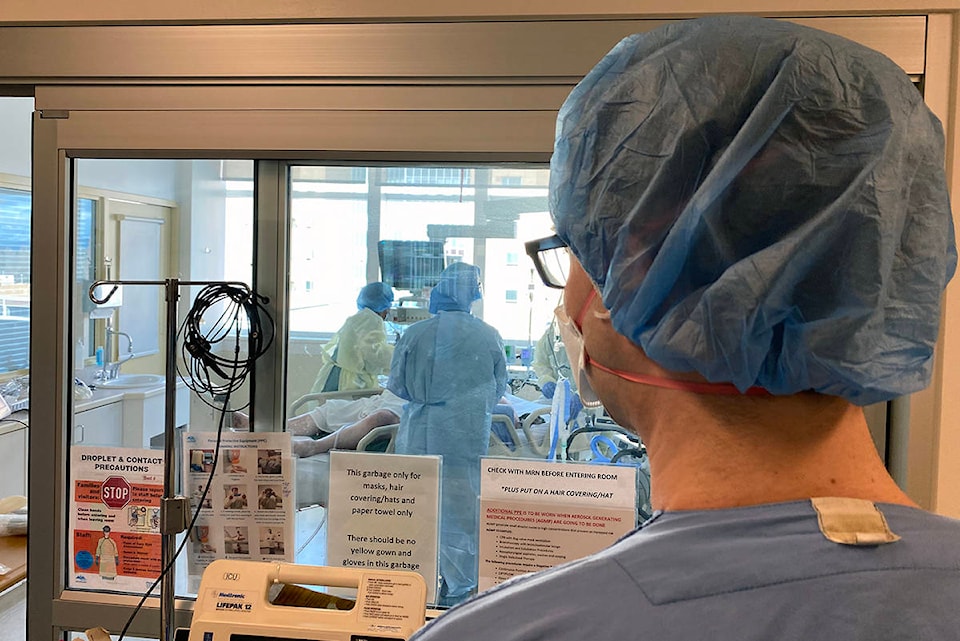Kendra Bronson, a respiratory therapist at the Royal Jubilee Hospital, hasn’t hugged her husband in over two months.
Since the pandemic hit, life has changed for Bronson. Her husband now lives out of their guest room, does the grocery shopping and runs all the errands that need to be done.
In the first weeks of COVID-19 arriving on the Island, Bronson had just gotten back from vacation herself. After isolating, she was back at work in the intensive care unit when the hospital had its first ventilated patient with the virus.
“So, I had to ventilate COVID patients that first week and at the same time, we had a lot of other sick patients in our unit because we’re still at the end of our influenza season,” she says.
Bronson describes her first week back at work after her vacation as stressful. With all these new procedures to protect health care workers and patients from the virus being implemented so quickly, that left little time to practise them.
READ ALSO: Greater Victoria emergency room visits down 40 per cent during pandemic
| Kendra Bronson, a respiratory therapist, says the beginning of the pandemic was stressful as procedures changed very quickly. (Courtesy of Kendra Bronson) |
“My first week back I had to do one of the high-risk procedures on this patient, which is assisting with intubation, and it was the first time that I had ever put on and taken off the extra precautions we have to wear. So that was definitely stressful.”
For the highest risk procedures, Bronson says she would wear a gown, two pairs of gloves, a bonnet, a hood, a face shield and a respirator. She says the added precautions can get pretty claustrophobic and make it hard to communicate with her coworkers and the patients.
Now, she says things are starting to calm down in the hospital.
“Changes are happening at a slower pace, so we feel like we’ve gotten on top of how to do all of our procedures, how to put on and take off all of our equipment that we’re needing to use, and starting to feel like we have a handle on it, and that’s why we feel safer now.”
Dr. Omar Ahmad, department head of Emergency and Critical Care Medicine for Island Health, says the number of emergency room visit were down at first, but recently they’ve started to increase. He describes the first weeks of the pandemic in the hospital as “kind of eerie.”
“We were all sort of wondering where are all these patients,” he says. “People still get infections, people still get heart attacks, people still have strokes, so where were all these people?”
According to Ahmad, those types of patients are starting to appear again, after a 40 per cent decrease in emergency room visits over the first four months of 2020 compared to the same time last year.
READ ALSO: Canadians’ worries shift from healthcare to social isolation as time goes on: StatsCan
Ahmad says at first there was “a lot of fear” in the hospital and a lack of communication didn’t help that. As a leader, Ahmad focused on building trust with the people he worked with, as well as communicating with his team regularly, ensuring everyone had proper personal protective equipment and making sure they knew those higher up were advocating for their safety.
He describes the people he works with as “warriors.”
“Even before COVID, they know they’re dealing with the unknown, they’re dealing with anything that could come through the door … They were ready to go to war as they always are and the bravery that they showed day to day was still there, it was just a different disease,” he says.
The 7 p.m. nightly cheers helped keep up the morale of health care workers, adds Ahmad. At first, he says he was quite touched by the banging of pots and loud claps, but as time went on he started to see it as a cheer for the community.
“It was like, wow we’re actually in this together and they’re clapping for us, but we’re actually clapping for them …”
“As a health care worker, I don’t see those drums for me anymore because I haven’t really done that much,” he says, besides the “tons and tons” of planning that went on.
As of May 18, there were 126 cases of COVID-19 on the Island, with only one COVID-19 patient in hospital.
For more news from the Island and beyond delivered directly to your email inbox, click here.
kendra.crighton@blackpress.ca
Follow us on Instagram
Like us on Facebook and follow us on Twitter.
